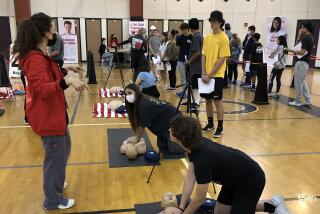Fitness Clubs Are Urged to Install Defibrillators
- Share via
Devices to shock stopped hearts back into normal rhythm have become common in airports, shopping malls, stadiums and schools--but not fitness clubs. Now doctors are saying it’s time that changed.
The American Heart Assn. and the American College of Sports Medicine are urging that gyms and health centers, frequented by increasing numbers of middle-age and older people, be equipped with automatic external defibrillators.
Neither states nor the federal government require that gyms have the potentially lifesaving devices on hand, and the doctor groups’ joint recommendation, which lacks the force of law, isn’t likely to prompt quick action.
Nevertheless, the International Health, Racquet and Sportsclub Assn. has begun to see the value in having them on hand, and change could be on the way.
Last March, after two years of batting the issue around, the Boston-based organization began encouraging its member clubs to investigate “the advantage of deploying and equipping their facilities with an AED or AEDs as needed,” said William C. Howland Jr., director of public relations and research for the organization.
Howland cited several reasons for the industry’s reluctance to install the devices. Clubs “had to feel it was truly foolproof, user-friendly technology, and we didn’t feel until recently that the equipment was,” he said. They needed to believe “that a layperson could reliably use the equipment and not do damage.” And the price had to fall.
Portable defibrillators cost $3,000 to $4,500. Most include simple directions explaining how to use them when someone has suffered cardiac arrest, typically brought on by an erratic heart rhythm that suddenly causes the heart to stop beating.
A survey taken a year ago showed that one out of four IHRSA clubs had defibrillators. In an interview last week while attending an international convention of health club operators in Phoenix, Howland said that “most people you talk to are looking into the equipment.... It will not be long before most of the top operators have gone ahead and made the investment.”
Some club owners remain worried about whether Good Samaritan laws--which say that a layperson acting in good faith to save someone’s life can’t be prosecuted if something goes wrong--would protect the clubs from legal liability if someone other than a trained club staffer deployed the equipment.
The club owners are also wondering about a very fundamental factor: How many people are stricken while at the gym?
One survey cited by the doctors found that of the 30 million people who regularly visit gyms, more than half are older than 35. And although there are no good data on fatalities in health clubs, a random survey of 65 facilities in Ohio found that 17% had had a club member suffer a heart attack or sudden cardiac death in the previous five years. Only 3% of the facilities had defibrillators when the emergency occurred. Another study of 2.9 million members of a large health club chain found 71 deaths in a two-year period.
Despite the infrequency of the incidents, Howland said, “we have members who have deployed AEDs and in their first year have reported saves.”
The advice from the two doctors’ groups, which appeared in the March 4 issue of the American Heart Assn.’s journal Circulation, updates recommendations made in 1998, when the groups advised health clubs to screen exercisers for cardiovascular diseases, train their staff to know CPR and to recognize and respond to cardiac arrest, establish emergency response plans and conduct cardiac drills. Studies show clubs are falling behind on these recommendations as well.
More to Read
Sign up for Essential California
The most important California stories and recommendations in your inbox every morning.
You may occasionally receive promotional content from the Los Angeles Times.













